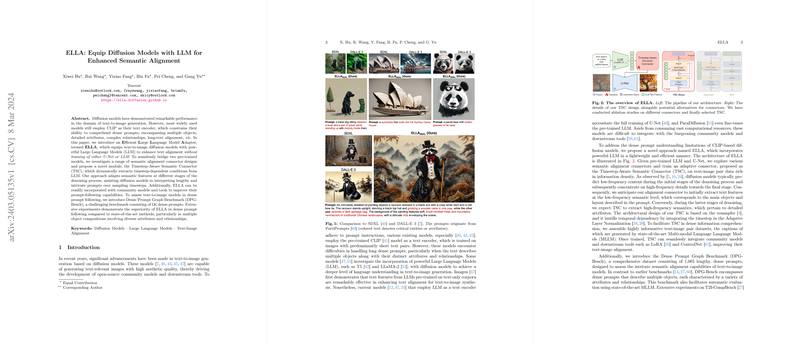ELLA: Bridging LLMs with Diffusion Models for Enhanced Text-to-Image Generation
Introduction
In the field of text-to-image generation, diffusion models have emerged as a dominant force, enabling the creation of images that are strikingly accurate and artistically coherent in response to textual prompts. Among these, models leveraging the CLIP architecture for text encoding have become mainstream due to their proficiency in generating aesthetically pleasing images. However, they often falter when faced with complex prompts that detail dense semantic content, including the depiction of multiple objects, their attributes, and relationships. Recognizing this limitation, Xiwei Hu, Rui Wang, Yixiao Fang, Bin Fu, Pei Cheng, and Gang Yu introduce an innovative approach called ELLA (Efficient LLM Adapter). ELLA leverages the profound comprehensibility of LLMs (LLM) to enhance the semantic alignment capability of text-to-image diffusion models. This is achieved without necessitating the retraining of the foundational U-Net architectures or the LLMs, presenting a less resource-intensive solution to improving prompt adherence in generated images.
Methodology
The core innovation of ELLA lies in its novel component, the Timestep-Aware Semantic Connector (TSC), which dynamically integrates timestep-dependent conditions extracted from an LLM. This method allows diffusion models to interpret and adhere to intricate textual prompts more faithfully throughout the image generation process. By intelligently adapting semantic features at different stages of denoising using TSC, ELLA enables pre-existing CLIP-based models to parse and visually render longer and more detailed textual descriptions effectively.
To corroborate the efficacy of ELLA, the authors meticulously designed a Dense Prompt Graph Benchmark (DPG-Bench) comprising 1,000 complex prompts to challenge text-to-image models with dense semantic content. The benchmark was carefully curated to highlight the limitations of existing models in following dense prompts, presenting a comprehensive toolkit for quantitative assessment in this niche.
Key Findings and Contributions
The research presented in the paper makes several notable contributions to the field of generative AI and text-to-image synthesis:
- ELLA significantly enhances the prompt-following capabilities of existing diffusion models by incorporating semantic depth and understanding through LLMs.
- The Timestep-Aware Semantic Connector is introduced as a flexible and efficient mechanism to inject LLM-derived semantic context into the image generation process, dynamically adjusting to the different phases of detail refinement in diffusion models.
- The authors also introduce the Dense Prompt Graph Benchmark, a challenging dataset designed to evaluate the ability of text-to-image models to adhere to complex, detailed prompts, marking an advance in benchmarking practices within the field.
Implications and Future Directions
ELLA's capability to improve the alignment between detailed textual prompts and the generated images opens up new avenues for exploring detailed, narrative-driven image creation. This aspect holds significant potential for applications in digital art creation, game development, and other creative industries seeking more intricate control over automated visual content generation.
Looking forward, the compatibility of ELLA with existing downstream tools and community models, such as adaptations for specific aesthetic styles or domains, underscores its potential for broad applicability and further innovation. The research paves the way for future work aimed at even more tightly integrated LLM and diffusion model architectures that could offer enhanced capabilities, including the generation based on mixed text and image inputs or real-time interactive image editing influenced by complex textual prompts.
Conclusion
In conclusion, "ELLA: Equip Diffusion Models with LLM for Enhanced Semantic Alignment" represents a significant step forward in addressing the challenge of generating imagery from text that encompasses densely packed semantic information. Through the strategic deployment of LLMs in enhancing the comprehension and execution capabilities of diffusion-based text-to-image models, without the need for extensive retraining, ELLA sets a new benchmark in the field. Its contributions, from the novel TSC to the DPG-Bench, not only enhance the capabilities of existing models but also provide a foundation for future research directions in generative AI.
